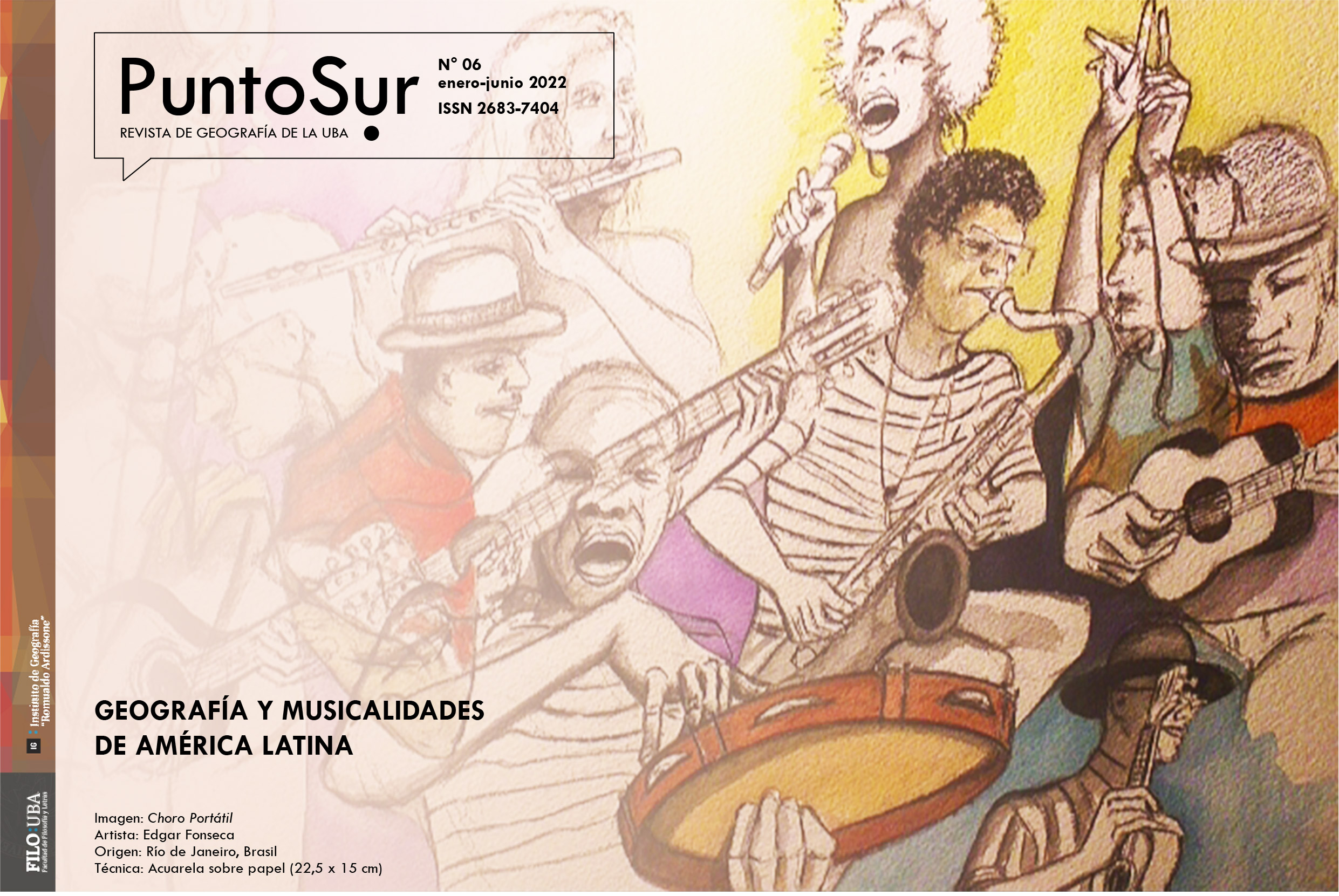Paisajes musicales del patrimonio y la memoria: investigando la construcción musical de lugar
Palabras clave:
Patrimonio, Memoria
Resumen
-Descargas
La descarga de datos todavía no está disponible.
Citas
Bibliografía
Anderson, B. (2004). Recorded music and practices of memory. Social and Cultural Geography, 5, 1-17.
Anderson, B. y Harrison, P. (2010). The Promise of Non-Representational Theories. En B. Anderson y P. Harrison (Eds.), Taking Place: Non-Representational Theories and Geography (pp. 1-34). Burlington: Ashgate.
Anderson, B., Morton, F. y Revill, G. (2005). Editorial: Practices of music and sound. Social and Cultural Geography, 6, 639-644.
Castro, F. (1993). Speech on the 40th Anniversary of the Assault on the Moncada Barracks. Recuperado de: http://www.cuba.cu
Cochrane, A. (1998). Illusions of power: interviewing local elites. Environment and Planning A, 30(12), 2121-2132.
Crang, M. (2002). Qualitative methods: the new orthodoxy? Progress in Human Geography, 26(5), 647-655.
Creswell, J. (2013). Qualitative Inquiry and Research Design: Choosing Among Five Traditions. Thousand Oaks, CA: Sage.
De Certeau, M. (1988). The Practice of Everyday Life. Berkeley: The University of California Press.
Devereux, G. (1967). From Anxiety to Method in the Behavioral Sciences. The Hague: Mouton.
Dewsbury. J.D. (2003). Witnessing Space: Knowledge without Contemplation. Environment and Planning A, 35, 1907-1932.
Duffy, M. (2000). Lines of drift: festival participation and performing a sense of place. Popular Music, 19(1), 51-64.
Duffy, M. (2005). Performing identity within a multicultural framework. Social and Cultural Geography, 6(5), 677-692.
Duffy, M., Waitt, G., Gorman-Murray, A. y Gibson, C. (2011). Bodily rhythms: Corporeal capacities to engage with festival spaces. Emotion, Space and Society, 4, 17-24.
Elwood, S.A. y Martin, D.G. (2000). “Placing” Interviews: Location and Scales of Power in Qualitative Research. The Professional Geographer, 52(4), 649-657.
Fabienke, R. (2001). Labour markets and income distribution during crisis and reform. En C. Brundenius, y J. Weeks (Eds.), Globalization and Third World Socialism: Cuba and Vietnam (pp. 102-128). Houndmills: Palgrave.
Finn, J. (2009). Contesting Culture: Commodification in Cuban Music. GeoJournal, 74(3), 191-200.
Finn, J. (2011a). Introduction: On Music and Movement… Aether: The Journal of Media Geography, 7, 1-11.
Finn, J. (2012). Entre la historia y el patrimonio: la raza debajo de la superficie del paisaje urbano. Estudios Socioterritoriales, 12(2), 37-66.
Finn, J. (2013). Representação, Música e Geografia: Repensando o “lugar” da música. En W. Oliveira y V. Cazetta (Eds.), Grafias do Espaço: imagens da educação geográfica contemporânea (pp. 193-206). San Pablo: Editora Átomo e Alínea.
Finn, J. (2014). Soundtrack of a Nation: Race, Place, and Music in Modern Brazil. The Journal of Latin American Geography, 13(2), 67-95.
Finn, J. C. (2011b). The Resonance of Place: Music and Race in Salvador da Bahia, Dissertation in Geography, Arizona State University. Recuperado de: https://repository.asu.edu/items/9134
Frith, S. (1996). Music and Identity. En S. Hall y P. DuGay (Eds.), Questions of Cultural Identity (pp. 100-127). Londres: Sage.
Honey, M. (1999). Ecotourism and Sustainable Development: Who Owns Paradise? Washington D.C.: Island Press.
Ingold, T. (2007). Lines: A Brief History. Londres: Routledge.
Johnson, T. (2011). Salsa Politics: Desirability, Marginality, and Mobility in North Carolina’s Salsa Nightclubs. Aether: The Journal of Media Geography, 7, 97-118.
Kirshenblatt-Gimblett, B. (1995). Theorizing Heritage. Ethnomusicology, 39(3), 367-380.
Latham, A. (2003). Research, performance, and doing human geography: some reflections on the diary–photograph, diary-interview method. Environment and Planning A, 35, 1993–2017.
Latham, A. (2004). Researching and writing everyday accounts of the city: an introduction to the diary–photo diary–interview method. En C. Knowles y P. Sweetman (Eds.), Picturing the Social Landscape, Visual Methods and the Sociological Imagination (pp. 117-131). Londres and Nueva York: Routledge.
Lefebvre, H. (1996). Writings on Cities. Oxford: Blackwell.
Lefebvre, H. (2004). Rhythmanalysis: Space, Time and Everyday Life. Londres: Continuum.
Morton, F. (2005). Performing ethnography: Irish traditional music sessions and new methodological spaces. Social and Cultural Geography, 6(5), 661-676.
Paul, B. (1953). Interview Techniques and Field Relationships. En A. Kroeber (ed.), Anthropology Today: And Encyclopedic Inventory (pp. 430-451). Chicago: University of Chicago Press.
Revill, G. (2004). Performing French folk music: dance, authenticity and nonrepresentational theory. Cultural Geographies, 11, 199-209.
Risério, A. (1981). Carnaval Ijexá. Salvador: Corrupio.
Rodríguez, I. (1995). Turismo, hoy algo más que una perspectiva. Granma.
Saldanha, A. (2005). Trance and visibility at dawn: racial dynamics in Goa’s rave scene. Social and Cultural Geography, 6(5), 707-721.
Smith, S. (2000). Performing the (sound) world. Environment and Planning D: Society and Space, 18, 615-637.
Tedlock, B. (1991). From Participant Observation to the Observation of Participation: The Emergence of Narrative Ethnography. Journal of Anthropological Research, 47(1), 69-94.
Thrift, N. (2000a). Afterwords. Environment and Planning D: Society and Space, 18(2), 213-255.
Thrift, N. (2000b). Non-representational theory. En R. Johnston, D. Gregory, G. Pratt y M. Watts (Eds.), The Dictionary of Human Geography (pp. 556). Malden, MA: Blackwell Publishing.
Valentine, G. (1999). Doing household research: interviewing couples together and apart. Area, 31, 67-74.
Veissiere, S.P.L. (2010). Making a Living: The Gringo Ethnographer as Pimp of the Suffering in the Late Capitalist Night. Cultural Studies, 10(1), 29-39.
Wood, N. y Smith, S. (2004). Instrumental routes to emotional geographies. Social and Cultural Geography, 5(4), 533-548.
Wood, N., Duffy, M. y Smith, S. (2007). The art of doing (geographies of) music. Environment and Planning D: Society and Space, 25, 867-889.
Yin, R. (2003). Case Study Research: Design and Methods. Thousand Oaks, CA: Sage.
Zimbalist, A. (1994). Treading Water: Cuba’s Economic and Political Crisis. En D.E. Schulz (Ed.), Cuba and the Future (pp. 7-21). Westport, Conn: Greenwood Press.
Anderson, B. (2004). Recorded music and practices of memory. Social and Cultural Geography, 5, 1-17.
Anderson, B. y Harrison, P. (2010). The Promise of Non-Representational Theories. En B. Anderson y P. Harrison (Eds.), Taking Place: Non-Representational Theories and Geography (pp. 1-34). Burlington: Ashgate.
Anderson, B., Morton, F. y Revill, G. (2005). Editorial: Practices of music and sound. Social and Cultural Geography, 6, 639-644.
Castro, F. (1993). Speech on the 40th Anniversary of the Assault on the Moncada Barracks. Recuperado de: http://www.cuba.cu
Cochrane, A. (1998). Illusions of power: interviewing local elites. Environment and Planning A, 30(12), 2121-2132.
Crang, M. (2002). Qualitative methods: the new orthodoxy? Progress in Human Geography, 26(5), 647-655.
Creswell, J. (2013). Qualitative Inquiry and Research Design: Choosing Among Five Traditions. Thousand Oaks, CA: Sage.
De Certeau, M. (1988). The Practice of Everyday Life. Berkeley: The University of California Press.
Devereux, G. (1967). From Anxiety to Method in the Behavioral Sciences. The Hague: Mouton.
Dewsbury. J.D. (2003). Witnessing Space: Knowledge without Contemplation. Environment and Planning A, 35, 1907-1932.
Duffy, M. (2000). Lines of drift: festival participation and performing a sense of place. Popular Music, 19(1), 51-64.
Duffy, M. (2005). Performing identity within a multicultural framework. Social and Cultural Geography, 6(5), 677-692.
Duffy, M., Waitt, G., Gorman-Murray, A. y Gibson, C. (2011). Bodily rhythms: Corporeal capacities to engage with festival spaces. Emotion, Space and Society, 4, 17-24.
Elwood, S.A. y Martin, D.G. (2000). “Placing” Interviews: Location and Scales of Power in Qualitative Research. The Professional Geographer, 52(4), 649-657.
Fabienke, R. (2001). Labour markets and income distribution during crisis and reform. En C. Brundenius, y J. Weeks (Eds.), Globalization and Third World Socialism: Cuba and Vietnam (pp. 102-128). Houndmills: Palgrave.
Finn, J. (2009). Contesting Culture: Commodification in Cuban Music. GeoJournal, 74(3), 191-200.
Finn, J. (2011a). Introduction: On Music and Movement… Aether: The Journal of Media Geography, 7, 1-11.
Finn, J. (2012). Entre la historia y el patrimonio: la raza debajo de la superficie del paisaje urbano. Estudios Socioterritoriales, 12(2), 37-66.
Finn, J. (2013). Representação, Música e Geografia: Repensando o “lugar” da música. En W. Oliveira y V. Cazetta (Eds.), Grafias do Espaço: imagens da educação geográfica contemporânea (pp. 193-206). San Pablo: Editora Átomo e Alínea.
Finn, J. (2014). Soundtrack of a Nation: Race, Place, and Music in Modern Brazil. The Journal of Latin American Geography, 13(2), 67-95.
Finn, J. C. (2011b). The Resonance of Place: Music and Race in Salvador da Bahia, Dissertation in Geography, Arizona State University. Recuperado de: https://repository.asu.edu/items/9134
Frith, S. (1996). Music and Identity. En S. Hall y P. DuGay (Eds.), Questions of Cultural Identity (pp. 100-127). Londres: Sage.
Honey, M. (1999). Ecotourism and Sustainable Development: Who Owns Paradise? Washington D.C.: Island Press.
Ingold, T. (2007). Lines: A Brief History. Londres: Routledge.
Johnson, T. (2011). Salsa Politics: Desirability, Marginality, and Mobility in North Carolina’s Salsa Nightclubs. Aether: The Journal of Media Geography, 7, 97-118.
Kirshenblatt-Gimblett, B. (1995). Theorizing Heritage. Ethnomusicology, 39(3), 367-380.
Latham, A. (2003). Research, performance, and doing human geography: some reflections on the diary–photograph, diary-interview method. Environment and Planning A, 35, 1993–2017.
Latham, A. (2004). Researching and writing everyday accounts of the city: an introduction to the diary–photo diary–interview method. En C. Knowles y P. Sweetman (Eds.), Picturing the Social Landscape, Visual Methods and the Sociological Imagination (pp. 117-131). Londres and Nueva York: Routledge.
Lefebvre, H. (1996). Writings on Cities. Oxford: Blackwell.
Lefebvre, H. (2004). Rhythmanalysis: Space, Time and Everyday Life. Londres: Continuum.
Morton, F. (2005). Performing ethnography: Irish traditional music sessions and new methodological spaces. Social and Cultural Geography, 6(5), 661-676.
Paul, B. (1953). Interview Techniques and Field Relationships. En A. Kroeber (ed.), Anthropology Today: And Encyclopedic Inventory (pp. 430-451). Chicago: University of Chicago Press.
Revill, G. (2004). Performing French folk music: dance, authenticity and nonrepresentational theory. Cultural Geographies, 11, 199-209.
Risério, A. (1981). Carnaval Ijexá. Salvador: Corrupio.
Rodríguez, I. (1995). Turismo, hoy algo más que una perspectiva. Granma.
Saldanha, A. (2005). Trance and visibility at dawn: racial dynamics in Goa’s rave scene. Social and Cultural Geography, 6(5), 707-721.
Smith, S. (2000). Performing the (sound) world. Environment and Planning D: Society and Space, 18, 615-637.
Tedlock, B. (1991). From Participant Observation to the Observation of Participation: The Emergence of Narrative Ethnography. Journal of Anthropological Research, 47(1), 69-94.
Thrift, N. (2000a). Afterwords. Environment and Planning D: Society and Space, 18(2), 213-255.
Thrift, N. (2000b). Non-representational theory. En R. Johnston, D. Gregory, G. Pratt y M. Watts (Eds.), The Dictionary of Human Geography (pp. 556). Malden, MA: Blackwell Publishing.
Valentine, G. (1999). Doing household research: interviewing couples together and apart. Area, 31, 67-74.
Veissiere, S.P.L. (2010). Making a Living: The Gringo Ethnographer as Pimp of the Suffering in the Late Capitalist Night. Cultural Studies, 10(1), 29-39.
Wood, N. y Smith, S. (2004). Instrumental routes to emotional geographies. Social and Cultural Geography, 5(4), 533-548.
Wood, N., Duffy, M. y Smith, S. (2007). The art of doing (geographies of) music. Environment and Planning D: Society and Space, 25, 867-889.
Yin, R. (2003). Case Study Research: Design and Methods. Thousand Oaks, CA: Sage.
Zimbalist, A. (1994). Treading Water: Cuba’s Economic and Political Crisis. En D.E. Schulz (Ed.), Cuba and the Future (pp. 7-21). Westport, Conn: Greenwood Press.
Publicado
2022-09-19
Cómo citar
Finn, J. (2022). Paisajes musicales del patrimonio y la memoria: investigando la construcción musical de lugar. Punto Sur, (6). https://doi.org/10.34096/ps.n6.11368
Sección
Dossier






















